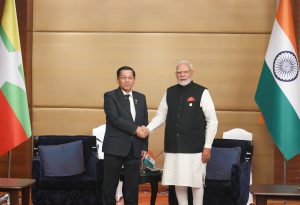Myanmar’s opposition National Unity Government (NUG) has made a strong case for India’s increased engagement with the country’s resistance movement aimed at toppling the military regime.
“This is the right time for India to intervene aggressively in Burma (Myanmar) in support of the NUG and Spring Revolution,” the NUG’s media representative in India Aung Nay Nyo, who is also a journalist with the NUG-affiliated PVT media outlet, told The Diplomat.
The appeal came even as India reiterated the need for early restoration of the democratic process in the disturbed country. During his recent meeting with Myanmar’s military junta chief Gen Min Aung Hlaing on the margins of the BIMSTEC Summit in Bangkok, India’s Prime Minister Narendra Modi pledged Indian assistance for aid and relief to the people impacted by the recent devastating earthquake. He also urged the military chief to expedite the country’s transition to a “peaceful, stable and democratic future.”
In a continuation of its earlier policy, the Indian government has continued to engage with the junta after the military coup four years ago. Senior Indian officials have even visited Myanmar to meet top junta officials.
“India wants to maintain some sort of a status quo, which means cordial ties with the junta. India should understand the reality [on the ground] and the fact that the military regime controls no more than 30 per cent of the entire country,” Aung Nay Nyo said. He attributed the Indian government’s “myopic vision” on Myanmar to its preoccupation with the border.
However, he said that “the Indian government’s policies to Myanmar have undergone changes over the past few years but not to the desired level.”
In 1988, when Myanmar’s generals brutally crushed mass protests, India was at the forefront of global criticism of the military crackdown. India provided sanctuary to thousands of people who fled the violence or were displaced from their homes. In 1992, India supported a United Nations resolution sponsored by the U.S and other Western countries condemning the junta for its violation of human rights.
The NUG would like India to actively assist the resistance movement against the junta in a manner is similar to its role in the aftermath of the 1988 uprising.
In addition, the NUG expects Indian recognition and enhancement of the status of NUG representatives in the country.
In the early-mid 1990s, India, in a shift away from supporting the pro-democracy movement, adopted a “pragmatic” policy of engaging the generals. Economic and security interests drove that policy shift.
Such interests remain strong and underlie its post-coup engagement of the military junta. The Indian government feels that its projects in Myanmar that are linked to its Act East Policy could be jeopardized without the cooperation of the junta. But despite its cooperation with the generals, Indian projects remain in limbo. And it is only after the Arakan Army agreed to support the Kaladan Multi-Modal Transit Transport Project that work on the highway from the India-Myanmar border to Paletwa could commence.
Yet, New Delhi is cautious. It would like to be seen pursuing a middle path in Myanmar since it is not yet certain when the Spring Revolution will draw to a close.
Comparing the policies of India and China towards Myanmar, Aung Nay Nyo observed that China is a “business-minded country,” which has “changed its policies frequently depending upon the circumstances in Myanmar.” It is quick to seize opportunities. In the early 1990s, Aung Nay Nyo added, there was a severe power shortage in Myanmar. Seeing the opportunity, “Chinese businessmen took advantage of the situation and established factories that manufactured LED bulbs. Their use spread in rural areas as these bulbs consumed less power.”
India has “not been able to match China’s shrewd policies in Myanmar,” the NUG representative claimed, adding that it “has been very slow to react in comparison to China.”
However, India is in an advantageous position. Aung Nay Nyo drew attention to the “growing anti-Chinese sentiment in some regions of Myanmar such as Monywa in Sagaing Region and Mandalay, where there are several China-funded projects. Unlike China, which evokes negative sentiments among the people of Myanmar, “our people want to rely upon and get closer to India,” Aung Nan Nyo said, pointing to the “ties between Burma and India that go back over 2000 years, especially in the realms of culture and religion.”
Another reason for the NUG to be alarmed over China is the deployment of Chinese troops disguised as private security guards to protect some of the China-funded projects. Aung Nan Nyo urged India to “be aware and initiate ‘precautionary measures’ over these developments in Myanmar.”
Aung Nay Nyo elaborated on the future of the Spring Revolution and the weaknesses that it suffers from via-a-vis the junta. “Our revolution began from point zero but our position has been improving. And although we do not have bullets to complete the Spring Revolution immediately, it is certain that the junta will be toppled either this year or the next.”
According to Aung Nay Nyo, the military has over 400,000 soldiers with a proper chain of command. “But the attrition rate in the military is very high and it is an extremely demoralized force. We are advancing slowly but certainly towards victory,” the NUG representative said.
However, he admitted that the NUG needs weapons, ammunition, and medicines as well as greater unity among the resistance groups for an effective campaign against the junta. Aung Nay Nyo appealed to friendly countries for material support to strengthen the resistance movement. The new policies unleashed by the Donald Trump administration in the U.S., implying a drastic reduction of financial assistance to the resistance, will not have “any debilitating impact on the Spring Revolution,” he said.

































